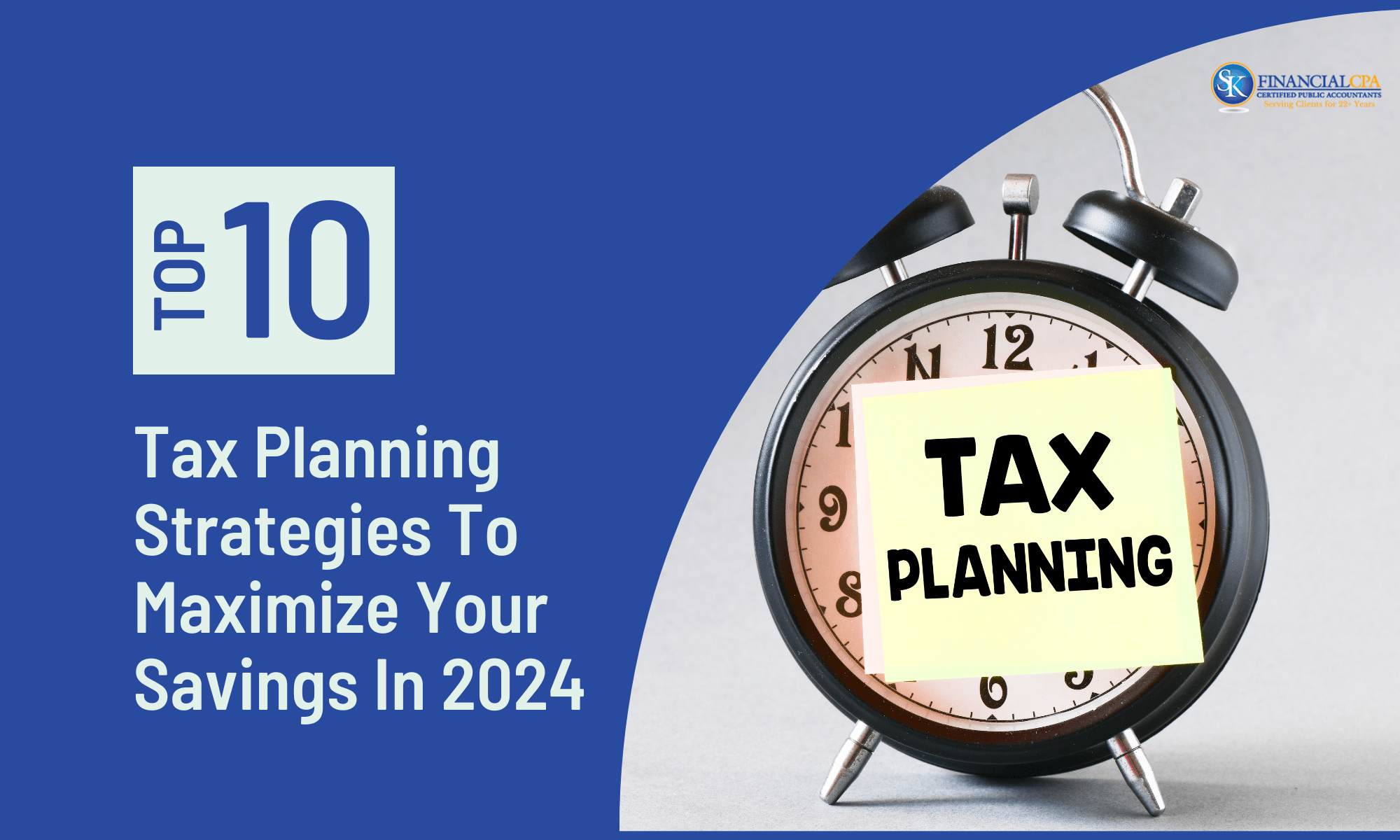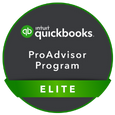
10 Tax Planning Strategies To Maximize Your Savings In 2024
A comprehensive and strategic approach to tax planning strategies is pivotal for individuals and businesses aiming to enhance their financial prosperity and minimize their obligations to the tax authorities. Understanding and implementing various tax planning strategies is beneficial and imperative for economic growth and sustainability in an ever-evolving tax landscape. Effective tax planning involves a proactive examination of financial plans from a tax perspective, aiming to capitalize on available tax benefits, deductions, and credits, all while ensuring compliance with the law.
This proactive approach safeguards against potential pitfalls and liabilities and leverages opportunities to reduce tax burdens through lawful means. Whether you're an individual looking to optimize your personal finances or a business owner strategizing for your enterprise's fiscal health, being well-versed in diverse tax planning strategies is key. It enables you to make informed decisions that align with your financial goals, ultimately leading to enhanced wealth accumulation and retention.
Below, we explore ten essential tax planning strategies designed to navigate the complexities of tax regulations effectively. These tax planning strategies are tailored to provide actionable insights and maximize your financial efficiency. For each strategy, we outline key points highlighting crucial considerations, ensuring you have a solid foundation to build upon in your tax planning endeavours.
What Is Tax Planning?
Tax planning is the process of organizing your finances in a way that minimizes your tax liability while remaining compliant with the law. It involves analyzing your financial situation, income, expenses, investments, and other relevant factors to identify strategies and opportunities for legally reducing the amount of taxes you owe.
Key Points
-
Proactive Planning: Tax planning involves proactive strategies to minimize tax liabilities by understanding applicable tax laws, maximizing deductions and credits, and optimizing financial decisions.
-
Long-Term Focus: Effective tax planning considers long-term financial goals and incorporates strategies for wealth accumulation, retirement planning, and estate management to minimize tax burdens over time.
-
Compliance and Ethics: While tax planning aims to minimize tax liabilities within the bounds of the law, it's crucial to prioritize compliance and ethical practices to avoid legal issues and penalties.
Understanding Tax Planning
Tax planning is the practice of strategically managing finances to minimize tax liabilities within the framework of applicable laws and regulations. It involves understanding tax laws, analyzing financial situations, and implementing various strategies to optimize tax outcomes. These strategies may include maximizing deductions and credits, utilizing tax-efficient investment vehicles, and timing income and expenses. By aligning tax planning strategies with long-term financial goals, individuals and businesses can navigate the complexities of the tax system more effectively while maximizing after-tax income and wealth accumulation.
Tax planning strategies
1. Retirement Account Contributions for Tax Efficiency
Contributing to retirement accounts like 401(k)s and IRAs is a cornerstone strategy for saving for retirement and managing your current tax liability. These contributions are particularly advantageous because they reduce your taxable income, potentially lowering your current year's tax bill. For traditional retirement accounts, the money you contribute is deducted from your taxable income, meaning you won't pay taxes on this income until you withdraw it in retirement, presumably at a lower tax rate.
|
Account Type |
Standard Contribution Limit |
Catch-Up Contribution Limit (Age 50+) |
|
401(k), 403(b), 457 |
$20,500 |
Additional $6,500 |
|
Traditional IRA |
$6,000 |
Additional $1,000 |
|
Roth IRA |
$6,000 |
Additional $1,000 |
|
SIMPLE IRA |
$14,000 |
Additional $3,000 |
-
Insights
-
Understand annual contribution limits to maximize tax-deferred growth potential.
-
Evaluate the merits of traditional versus Roth contributions based on your current tax bracket, expected future income, and tax rates in retirement.
-
For those nearing retirement, assess catch-up contribution options to boost your savings further.
-
Retirement contributions can be strategically timed to optimize tax benefits, especially if your income fluctuates annually.
2. Maximizing the Benefit of Flexible Spending Accounts (FSAs)
Flexible Spending Accounts offer a powerful way to save money on taxes while paying for medical and dependent care expenses. By setting aside a portion of your earnings in an FSA, you effectively reduce your taxable income. These contributions are made pre-tax, lowering your overall tax liability. Planning is essential with FSAs due to their use-it-or-lose-it nature, which requires you to carefully estimate your upcoming medical and care expenses for the year.
-
Insights
-
Analyze your previous year's medical and dependent care spending to accurately forecast future needs.
-
Stay informed about eligible expenses and recent changes to FSA rules, which can affect your planning.
-
Consider strategies for using leftover FSA funds at the end of the plan year, such as stocking up on eligible supplies.
-
For those with variable health expenses, balance the risk of overcontributing against the tax-saving benefits.
3. Home Office Deduction to Lower Taxable Income
The home office deduction is a valuable tax break for self-employed individuals, freelancers, and remote workers who meet certain criteria. By deducting a portion of your home expenses as business expenses, you can significantly reduce your taxable income. This deduction covers direct expenses of the home office (like repairs) and a portion of indirect expenses (such as rent, utilities, and home insurance). The key is that the space must be used regularly and exclusively for business.
-
Insights
-
Understand the specific requirements to qualify for the home office deduction, including what constitutes "regular and exclusive" use.
-
Explore the simplified option for calculating the home office deduction versus the regular method, to determine which is more beneficial for you.
-
Keep meticulous records of all expenses related to your home office and business use of your home.
-
Consider the potential impact of the home office deduction on the future sale of your home, as it may affect the calculation of capital gains tax.
4. Investing Wisely with Capital Gains and Losses for Tax Advantages
A capital gains tax strategy is an essential aspect of investment planning. By understanding and utilizing the tax rules around capital gains and losses, you can significantly influence your tax liability. Long-term capital gains are taxed at preferential rates compared to short-term gains. Strategically selling assets to realize losses can offset gains and reduce your taxable income, a process known as tax loss harvesting.
-
Insights
-
Regularly review your investment portfolio for opportunities to harvest losses or realize gains in a tax-efficient manner.
-
Understand the wash-sale rule to avoid disqualifying a loss.
-
Plan the timing of asset sales to manage your exposure to different capital gains tax rates effectively.
-
Consider the impact of state taxes on capital gains and incorporate this into your overall investment strategy.
5. Alternative Minimum Tax (AMT) to Prevent Tax Surprises
The Alternative Minimum Tax (AMT) is designed to ensure that high-income taxpayers pay a minimum amount of tax, regardless of deductions and credits. Understanding the AMT and planning to minimize its impact can prevent unexpected increases in your tax liability. This parallel tax calculation disallows certain deductions, potentially leading to a higher tax bill for some taxpayers.
-
Insights
-
Familiarize yourself with the triggers that may subject you to the AMT, including large deductions and certain types of income.
-
Engage in tax planning to avoid or reduce AMT exposure, such as spreading out deductible expenses or deferring income.
-
Regularly evaluate your potential AMT liability, especially if your financial situation changes, to avoid surprises.
-
Consult with a tax professional to explore advanced strategies for minimizing AMT impact, particularly if you are consistently close to the AMT threshold.
Essential Tax Document Checklist for 2024 
|
Category |
Items |
|
Income |
W-2 form(s) |
|
Bank statements |
|
|
1099-MISC |
|
|
1099-NEC |
|
|
1099-INT |
|
|
1099-DIV |
|
|
1099-K |
|
|
Brokerage statements |
|
|
Alimony received |
|
|
K-1 form(s) |
|
|
Expenses & Deductions |
Receipts |
|
Invoices |
|
|
Alimony paid |
|
|
Statements from charities |
|
|
Gambling losses |
|
|
Home |
Closing statements |
|
Purchase and sales invoices |
|
|
Insurance records |
|
|
Property tax assessments |
|
|
Retirement Accounts |
Form 5498 (IRA contributions) |
|
Form 8606 (nondeductible IRA contributions) |
|
|
401(k) statements |
|
|
Distribution records |
|
|
Annual statements |
|
|
Other Investments |
Transaction data (purchase/sale receipts) |
|
Annual statements |
6. Estate Planning and Gift Tax Strategies for Tax-Efficient Wealth Transfer
Estate planning and understanding gift tax rules are crucial for tax-efficient wealth transfers to heirs. Through strategic gifting and the use of trusts, you can significantly reduce the size of your taxable estate, thereby minimizing estate taxes. Leveraging annual gift exclusions and understanding the lifetime estate and gift tax exemption are key components of these tax planning strategies
-
Insights
-
Develop a comprehensive estate plan that includes strategies for gifting and trusts to manage your estate's size and tax exposure.
-
Stay informed about estate and gift tax law changes, which can affect your planning.
-
Consider the implications of gifting assets with high appreciation potential to maximize tax benefits for beneficiaries.
-
Work with estate planning professionals to ensure your strategies align with your financial and legacy goals.
7. Education Savings Plans for Tax Benefits and Future Savings
Education savings plans, such as 529 plans and Coverdell Education Savings Accounts (ESAs), offer tax-advantaged ways to save for education expenses. Contributions to these plans grow tax-free, and withdrawals for qualified education expenses are also tax-free. Understanding tax planning strategies and each type of plan's features, benefits, and limitations can help you maximize your savings and tax advantages.
-
Insights
-
Compare the features of 529 plans and Coverdell ESAs to determine which best suits your education savings goals.
-
Investigate the specific tax benefits your state offers for contributions to 529 plans.
-
Plan contributions to maximize tax advantages while considering the future education needs of the beneficiary.
-
Stay informed about the evolving definition of "qualified education expenses," which can affect the tax-free status of withdrawals.
-
8. Charitable Giving and Donations for Tax Deductions and Social Impact
Charitable giving supports causes you care about and provides significant tax benefits if you itemize deductions. Donating cash, property, or appreciated securities can reduce your taxable income and avoid capital gains taxes in the case of appreciated securities. Strategic planning for charitable contributions can enhance the tax benefits of your generosity.
-
Insights
-
Explore various charitable giving vehicles, such as donor-advised funds or charitable trusts, to maximize tax advantages and align with your philanthropic goals.
-
Consider "bunching" charitable contributions yearly to surpass the standard deduction threshold and maximize tax benefits.
-
Document all charitable contributions meticulously to substantiate deductions during tax filing.
-
Review the impact of large donations on your overall tax situation, especially if you're nearing the limits on charitable deduction caps.
9. Qualified Small Business Stock (QSBS) for Capital Gains Exclusion
Investing in Qualified Small Business Stock (QSBS) presents an opportunity for significant tax savings for investors in small and emerging companies. Under Section 1202 of the Internal Revenue Code, investors can exclude up to 100% of capital gains from federal income taxes on the sale of QSBS held for more than five years, subject to certain limits and conditions. Understand business tax planning strategies
-
Insights
-
Understand the criteria for a stock to qualify as QSBS, including the business's nature and the company's size at the time of stock issuance.
-
Review the holding period requirements to ensure eligibility for the capital gains exclusion.
-
Be aware of the exclusion limits, which can vary based on when the stock was acquired.
-
Consider the impact of investing in QSBS on your overall investment strategy and risk tolerance, balancing the potential tax benefits with the inherent risks of investing in small business tax planning strategies.
10. Taking Advantage of Opportunity Zones for Deferred and Reduced Capital Gains
Opportunity Zones offer investors the chance to defer and potentially reduce capital gains taxes through investments in economically distressed areas. By reinvesting capital gains into Opportunity Zone Funds, investors can defer taxes on those gains and, depending on the length of the investment, reduce the taxable amount of the reinvested gains. Additionally, investments held for at least ten years may qualify for tax-free growth within the fund.
-
Insights
-
Identify the geographic locations designated as Opportunity Zones and explore investment opportunities within these areas.
-
Understand the timeline for investing capital gains into Opportunity Zone Funds to qualify for tax deferral and reduction benefits.
-
Review the specific requirements for deferring and reducing capital gains taxes, including the holding period for investments.
-
Consider the social and economic impact of your investment in Opportunity Zones, in addition to the potential tax benefits.
|
Tax Benefit Type |
Name |
Description |
Limitations or Cap |
|
Deduction |
Mortgage Interest Deduction |
Deduction on interest paid on mortgage of up to $750,000 of qualified loans |
Limited to $750,000 of debt |
|
Deduction |
State and Local Taxes (SALT) |
Deductionsen er for state and local property, income, and sales taxes |
Capped at $10,000 |
|
Deduction |
Charitable Contributions |
Deduction for donations to qualified organizations |
Limited to 60% of AGI |
|
Credit |
Child Tax Credit |
Credit for each qualifying child under the age of 17 |
Up to $2,000 per qualifying child |
|
Credit |
American Opportunity Credit |
Credit for qualified education expenses for the first four years of college |
Maximum of $2,500 per student |
|
Credit |
Lifetime Learning Credit |
Credit for qualified tuition and related expenses for higher education |
Up to $2,000 per tax return |
Understand Tax Planning strategies in United State
Tax planning strategies in the USA involve various methods to minimize tax liabilities while remaining compliant with tax laws.
Here are some key aspects of tax planning strategies in the USA:
Income Tax Planning: This involves managing income sources to optimize tax efficiency. Strategies may include timing income recognition, maximizing deductions, and utilizing tax credits.
Retirement Planning: Contributing to tax-advantaged retirement accounts such as 401(k)s, IRAs, and Roth IRAs can lower current taxable income while saving for retirement. Additionally, withdrawals from certain retirement accounts may be taxed at a lower rate during retirement.
Investment Tax Planning: Strategies focus on reducing taxes on investment income and gains. This can include holding investments for the long term to qualify for lower capital gains tax rates, tax-loss harvesting to offset gains with losses, and investing in tax-efficient securities.
Estate Tax Planning: For individuals with significant assets, estate tax planning involves strategies to minimize estate taxes upon death. This may include creating trusts, gifting assets during one's lifetime, and leveraging estate tax exemptions.
Business Tax Planning: For business owners, strategies include optimizing deductions, structuring business entities to minimize taxes, and taking advantage of available tax credits and incentives.
Charitable Giving: Donations to qualified charitable organizations can result in tax deductions. Strategic charitable giving can help reduce taxable income while supporting charitable causes.
Education Tax Planning: Utilizing tax-advantaged savings plans such as 529 plans and Coverdell Education Savings Accounts (ESAs) to save for education expenses can provide tax benefits.
Healthcare Tax Planning: Contributions to Health Savings Accounts (HSAs) and Flexible Spending Accounts (FSAs) can lower taxable income while covering medical expenses.
Real Estate Tax Planning: Strategies may include maximizing deductions related to real estate investments, taking advantage of depreciation deductions, and utilizing tax-deferred exchanges.
Tax Compliance and Reporting: Staying informed about tax laws and regulations, maintaining accurate records, and timely filing tax returns are essential for effective tax planning strategy and compliance.
FAQs
Q: What exactly are tax planning strategies, and why are they important?
Ans: Tax planning strategies are methods and approaches used to manage one's financial affairs to minimize tax liabilities and maximize tax benefits within the bounds of the law. They involve careful consideration of various financial decisions and tax laws to ensure tax efficiency. These strategies are important because they can significantly reduce the amount of taxes you owe, thereby increasing your savings and investments over time.
Q: Is tax planning only for the wealthy, or can anyone benefit from it?
Ans: Tax planning is beneficial for individuals and entities at all income levels, not just the wealthy. Whether you're an employee, self-employed, or a business owner, effective tax planning can help you take advantage of legal tax-saving opportunities, regardless of your financial status.
Q: When is the best time to start tax planning?
Ans: The best time to start tax planning is at the beginning of the fiscal year, as it gives you ample time to understand your financial situation, make informed decisions, and implement strategies throughout the year. However, it's never too late to start, and even late in the year, there are steps you can take to improve your tax situation.
Q: Do tax planning strategies change, and how can I stay updated?
Ans: Yes, tax planning strategies can change due to amendments in tax laws, adjustments in personal financial situations, or shifts in economic conditions. To stay updated, regularly consult with a tax professional, follow reliable financial news sources, and review official publications from tax authorities like the IRS.
Q: How does tax planning differ from tax evasion?
Ans: Tax planning is the legal process of optimizing your financial decisions to minimize tax liabilities within the framework of the law. Tax evasion, on the other hand, involves illegal practices to avoid paying taxes, such as underreporting income or claiming false deductions. Tax evasion is punishable by law, whereas tax planning is encouraged and rewarded by the tax system.
Q: What are the first steps to implementing tax planning strategies in my financial plan?
Ans: The first step is to assess your current financial situation and understand your short-term and long-term financial goals. Then, consult with a tax professional to identify strategies that align with your goals and comply with current tax laws. Finally, meticulously document and organize all your financial transactions to support your tax planning efforts.
Follow SKFinancial on Facebook / Twitter / Linkedin / Youtube for updates.








